Abstract
A point mutation in the mRNA of NADP(H): quinone oxidoreductase 1 (NQO1, DT-diaphorase) is believed to be responsible for reduced enzyme activity in the adenocarcinoma BE cell line. The present study examined nine cultured human non-cancerous fibroblast cell strains, five of which were from members of a single cancer-prone family, which demonstrated widely varying activity levels of DT-diaphorase (41 - 3462 nmol min-1 mg-1 protein), to determine if genetic alteration of the NQO1 or NOQ2 gene was involved in determining enzyme activity. All cell strains expressed NQO1 and NQO2 mRNA as measured by a quantitative polymerase chain reaction amplification technique. No relationship was found between the level of mRNA expressed and the enzyme activity in the cells. Sequencing of the entire complementary DNA from the cell strains revealed only a single base substitution at nucleotide 609 in one allele encoding NQO1 in every cell strain from members of the cancer-prone family, except for one cell strain which expressed only the T at nucleotide 609 in both alleles. Subsequent examination of genomic DNA from 44 individuals revealed that this base substitution is present in approximately 50% of the population. The presence of the T at nucleotide 609 in the NQO1 locus does not appear to be directly causal for altered DT-diaphorase activity.
Full text
PDF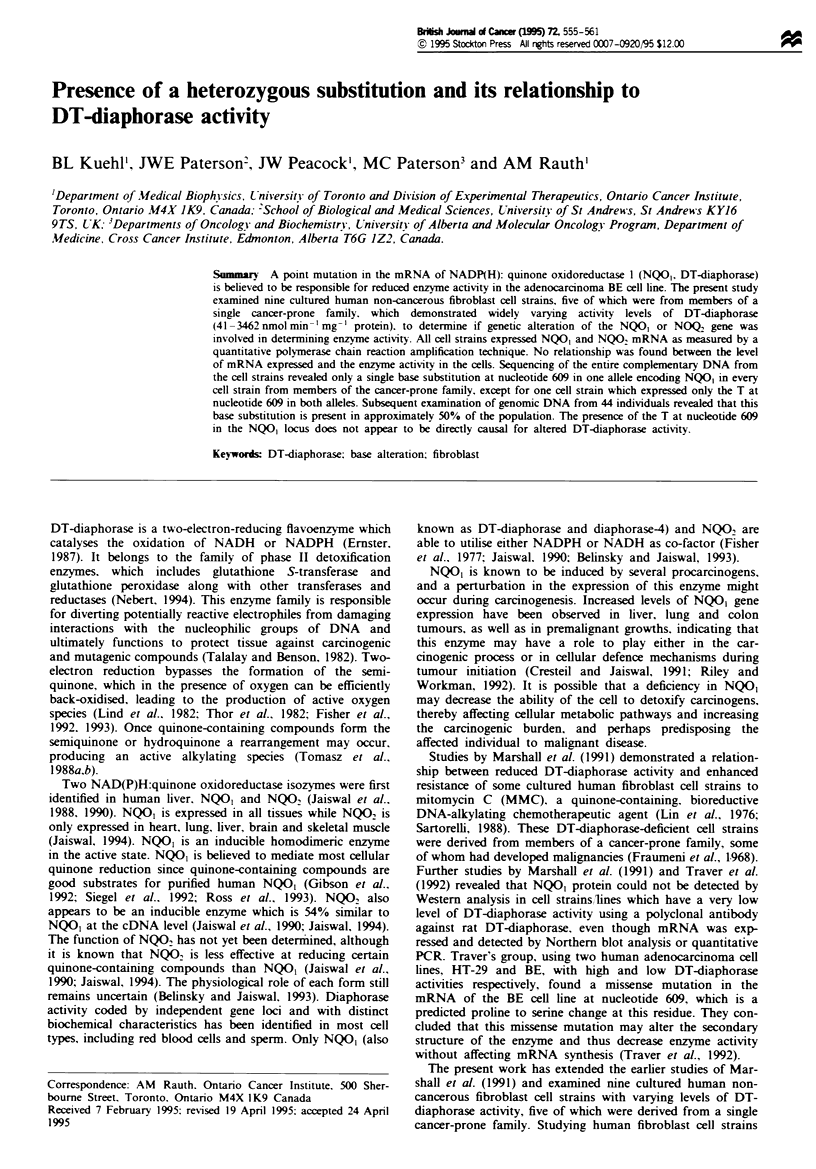
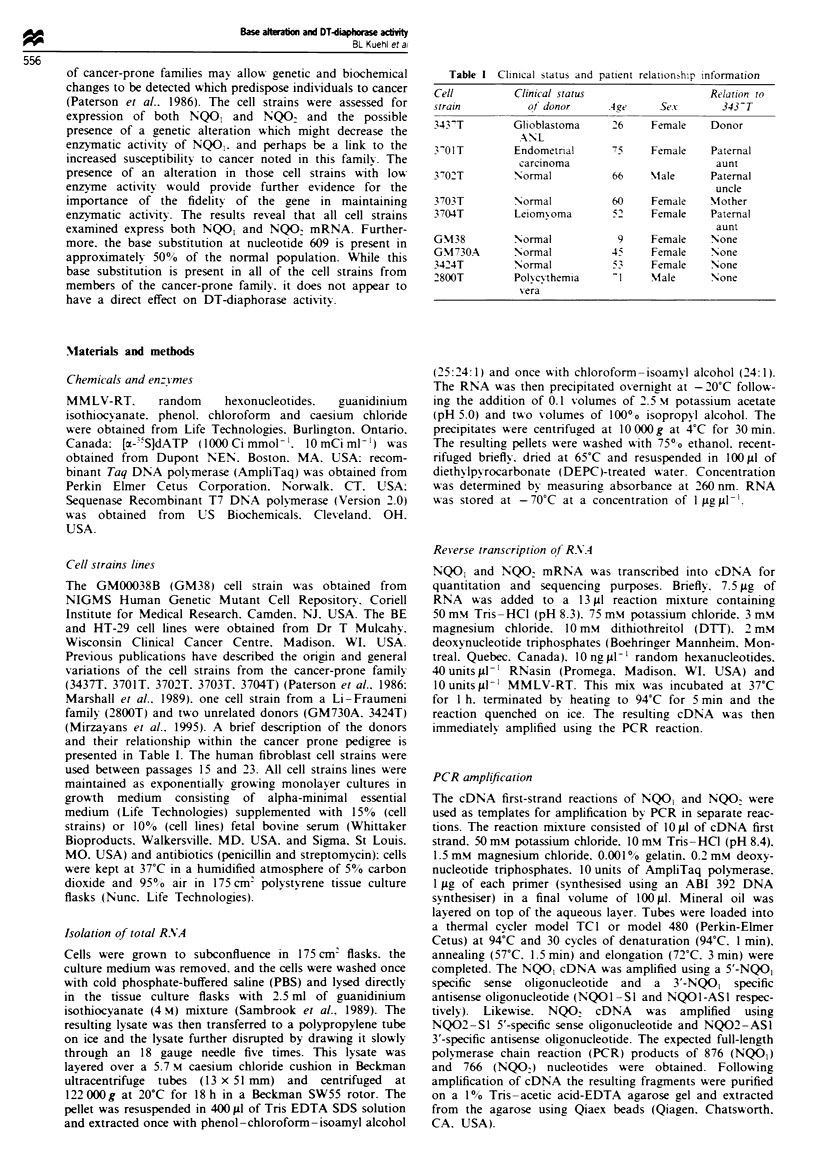
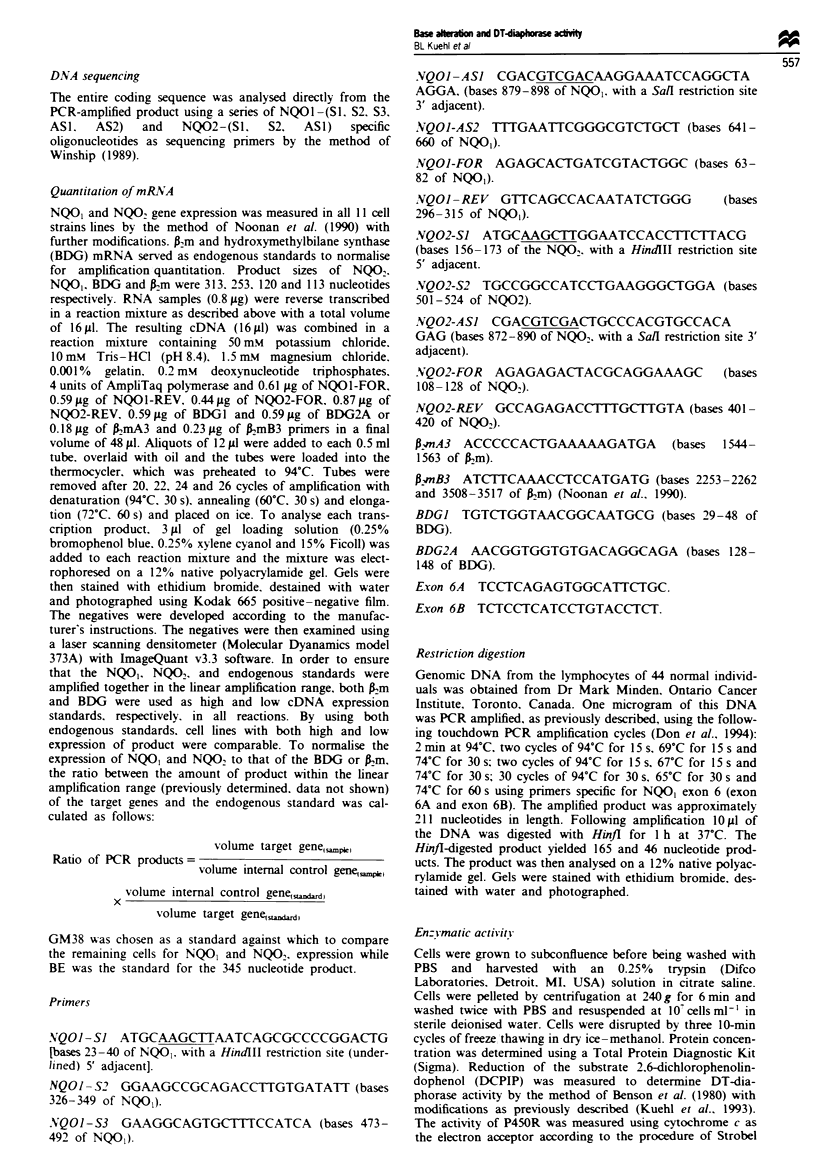

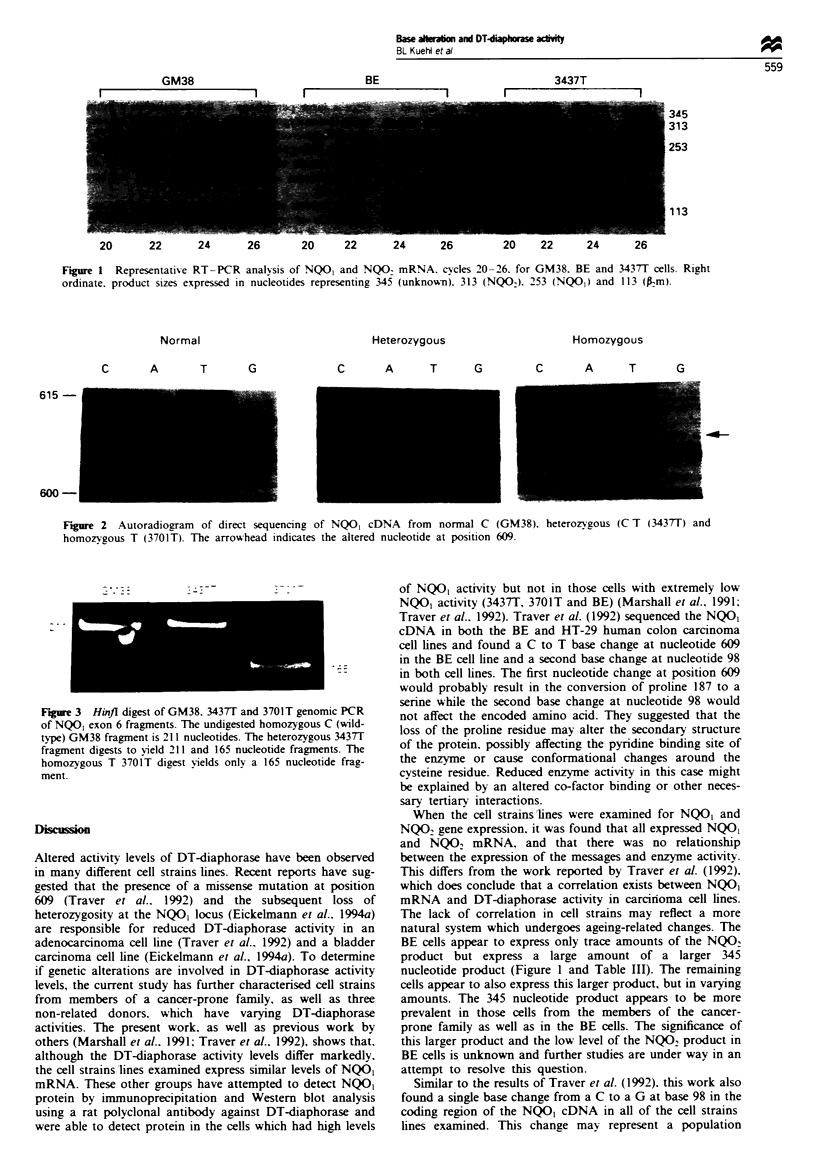
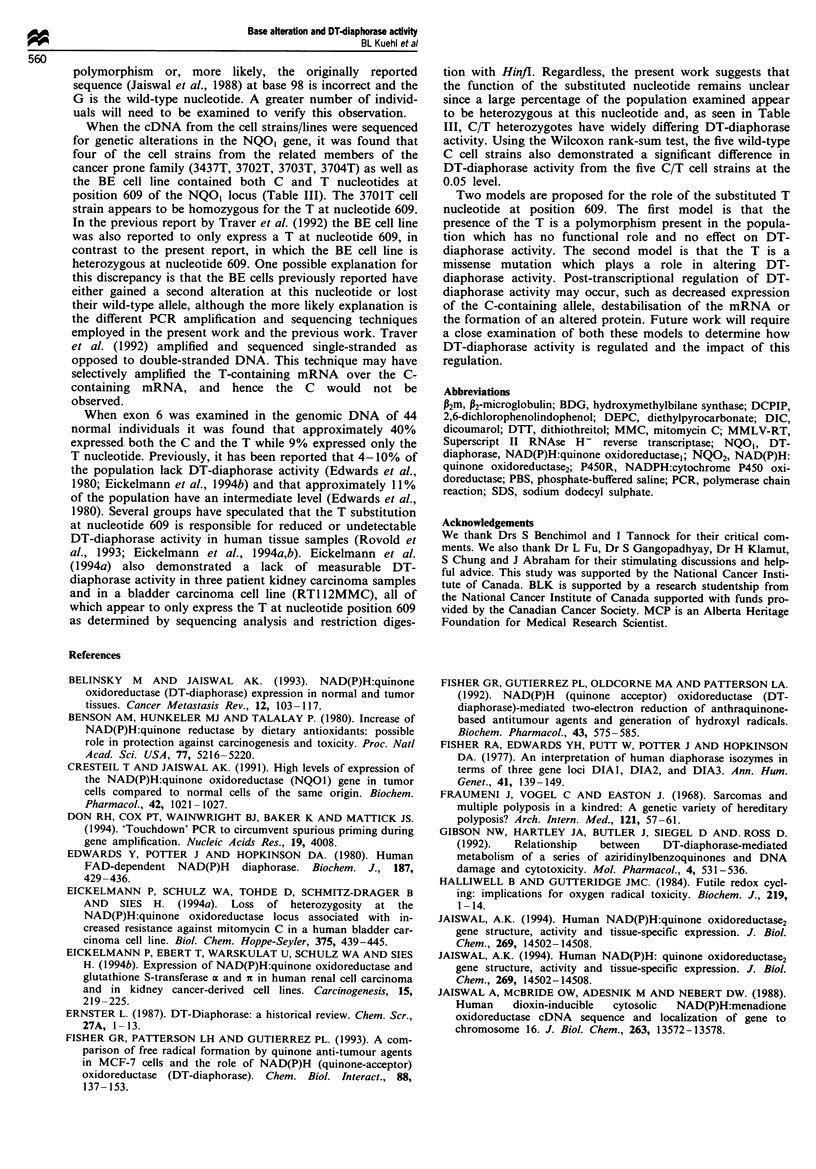
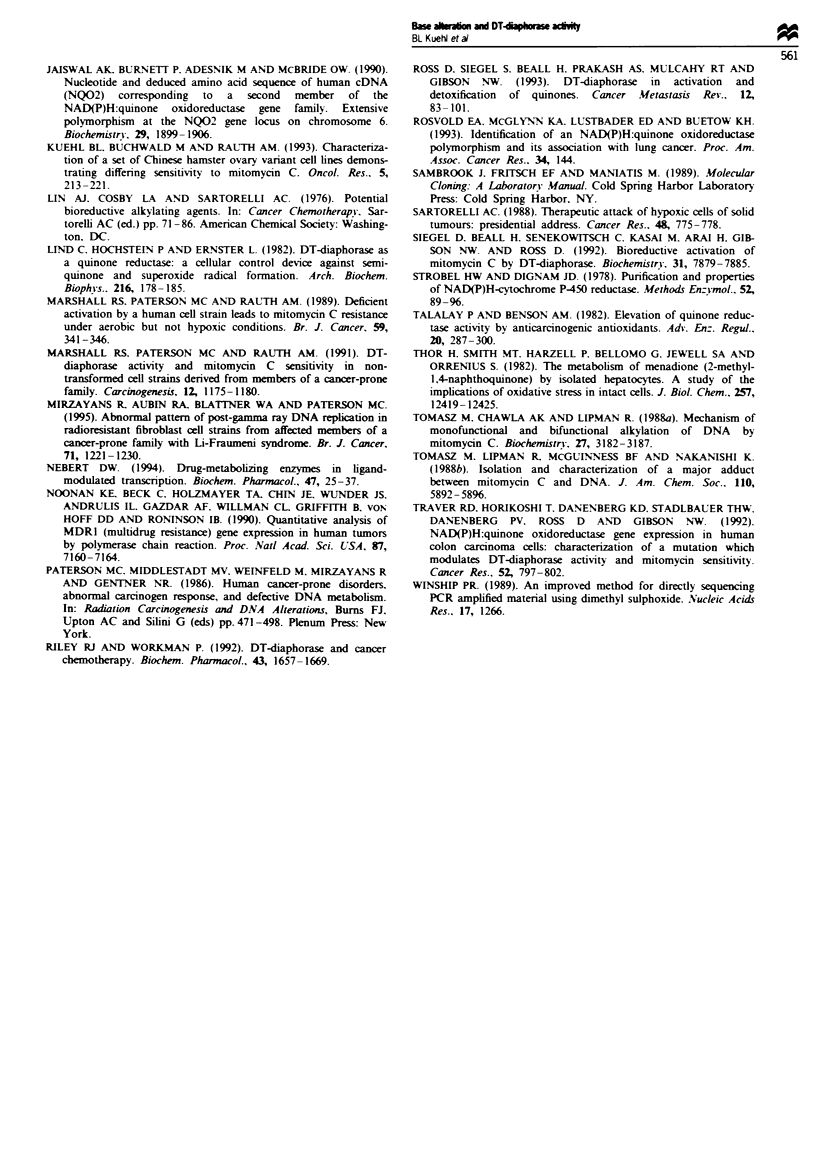
Images in this article
Selected References
These references are in PubMed. This may not be the complete list of references from this article.
- Belinsky M., Jaiswal A. K. NAD(P)H:quinone oxidoreductase1 (DT-diaphorase) expression in normal and tumor tissues. Cancer Metastasis Rev. 1993 Jun;12(2):103–117. doi: 10.1007/BF00689804. [DOI] [PubMed] [Google Scholar]
- Benson A. M., Hunkeler M. J., Talalay P. Increase of NAD(P)H:quinone reductase by dietary antioxidants: possible role in protection against carcinogenesis and toxicity. Proc Natl Acad Sci U S A. 1980 Sep;77(9):5216–5220. doi: 10.1073/pnas.77.9.5216. [DOI] [PMC free article] [PubMed] [Google Scholar]
- Cresteil T., Jaiswal A. K. High levels of expression of the NAD(P)H:quinone oxidoreductase (NQO1) gene in tumor cells compared to normal cells of the same origin. Biochem Pharmacol. 1991 Aug 8;42(5):1021–1027. doi: 10.1016/0006-2952(91)90284-c. [DOI] [PubMed] [Google Scholar]
- Don R. H., Cox P. T., Wainwright B. J., Baker K., Mattick J. S. 'Touchdown' PCR to circumvent spurious priming during gene amplification. Nucleic Acids Res. 1991 Jul 25;19(14):4008–4008. doi: 10.1093/nar/19.14.4008. [DOI] [PMC free article] [PubMed] [Google Scholar]
- Edwards Y. H., Potter J., Hopkinson D. A. Human FAD-dependent NAD(P)H diaphorase. Biochem J. 1980 May 1;187(2):429–436. doi: 10.1042/bj1870429. [DOI] [PMC free article] [PubMed] [Google Scholar]
- Eickelmann P., Ebert T., Warskulat U., Schulz W. A., Sies H. Expression of NAD(P)H:quinone oxidoreductase and glutathione S-transferases alpha and pi in human renal cell carcinoma and in kidney cancer-derived cell lines. Carcinogenesis. 1994 Feb;15(2):219–225. doi: 10.1093/carcin/15.2.219. [DOI] [PubMed] [Google Scholar]
- Eickelmann P., Schulz W. A., Rohde D., Schmitz-Dräger B., Sies H. Loss of heterozygosity at the NAD(P)H: quinone oxidoreductase locus associated with increased resistance against mitomycin C in a human bladder carcinoma cell line. Biol Chem Hoppe Seyler. 1994 Jul;375(7):439–445. doi: 10.1515/bchm3.1994.375.7.439. [DOI] [PubMed] [Google Scholar]
- Fisher G. R., Gutierrez P. L., Oldcorne M. A., Patterson L. H. NAD(P)H (quinone acceptor) oxidoreductase (DT-diaphorase)-mediated two-electron reduction of anthraquinone-based antitumour agents and generation of hydroxyl radicals. Biochem Pharmacol. 1992 Feb 4;43(3):575–585. doi: 10.1016/0006-2952(92)90581-3. [DOI] [PubMed] [Google Scholar]
- Fisher G. R., Patterson L. H., Gutierrez P. L. A comparison of free radical formation by quinone antitumour agents in MCF-7 cells and the role of NAD(P)H (quinone-acceptor) oxidoreductase (DT-diaphorase). Chem Biol Interact. 1993 Sep;88(2-3):137–153. doi: 10.1016/0009-2797(93)90088-g. [DOI] [PubMed] [Google Scholar]
- Fisher R. A., Edwards Y. H., Putt W., Potter J., Hopkinson D. A. An interpretation of human diaphorase isozymes in terms of three gene loci DIA1, DIA2 and DIA3. Ann Hum Genet. 1977 Oct;41(2):139–149. doi: 10.1111/j.1469-1809.1977.tb01908.x. [DOI] [PubMed] [Google Scholar]
- Fraumeni J. F., Jr, Vogel C. L., Easton J. M. Sarcomas and multiple polyposis in a kindred. A genetic variety of hereditary polyposis? Arch Intern Med. 1968 Jan;121(1):57–61. [PubMed] [Google Scholar]
- Gibson N. W., Hartley J. A., Butler J., Siegel D., Ross D. Relationship between DT-diaphorase-mediated metabolism of a series of aziridinylbenzoquinones and DNA damage and cytotoxicity. Mol Pharmacol. 1992 Sep;42(3):531–536. [PubMed] [Google Scholar]
- Halliwell B., Gutteridge J. M. Oxygen toxicity, oxygen radicals, transition metals and disease. Biochem J. 1984 Apr 1;219(1):1–14. doi: 10.1042/bj2190001. [DOI] [PMC free article] [PubMed] [Google Scholar]
- Jaiswal A. K., Burnett P., Adesnik M., McBride O. W. Nucleotide and deduced amino acid sequence of a human cDNA (NQO2) corresponding to a second member of the NAD(P)H:quinone oxidoreductase gene family. Extensive polymorphism at the NQO2 gene locus on chromosome 6. Biochemistry. 1990 Feb 20;29(7):1899–1906. doi: 10.1021/bi00459a034. [DOI] [PubMed] [Google Scholar]
- Jaiswal A. K. Human NAD(P)H:quinone oxidoreductase2. Gene structure, activity, and tissue-specific expression. J Biol Chem. 1994 May 20;269(20):14502–14508. [PubMed] [Google Scholar]
- Jaiswal A. K., McBride O. W., Adesnik M., Nebert D. W. Human dioxin-inducible cytosolic NAD(P)H:menadione oxidoreductase. cDNA sequence and localization of gene to chromosome 16. J Biol Chem. 1988 Sep 25;263(27):13572–13578. [PubMed] [Google Scholar]
- Kuehl B. L., Buchwald M., Rauth A. M. Characterization of a set of Chinese hamster ovary variant cell lines demonstrating differing sensitivity to mitomycin C. Oncol Res. 1993;5(6-7):213–221. [PubMed] [Google Scholar]
- Lind C., Hochstein P., Ernster L. DT-diaphorase as a quinone reductase: a cellular control device against semiquinone and superoxide radical formation. Arch Biochem Biophys. 1982 Jun;216(1):178–185. doi: 10.1016/0003-9861(82)90202-8. [DOI] [PubMed] [Google Scholar]
- Marshall R. S., Paterson M. C., Rauth A. M. DT-diaphorase activity and mitomycin C sensitivity in non-transformed cell strains derived from members of a cancer-prone family. Carcinogenesis. 1991 Jul;12(7):1175–1180. doi: 10.1093/carcin/12.7.1175. [DOI] [PubMed] [Google Scholar]
- Marshall R. S., Paterson M. C., Rauth A. M. Deficient activation by a human cell strain leads to mitomycin resistance under aerobic but not hypoxic conditions. Br J Cancer. 1989 Mar;59(3):341–346. doi: 10.1038/bjc.1989.67. [DOI] [PMC free article] [PubMed] [Google Scholar]
- Mirzayans R., Aubin R. A., Bosnich W., Blattner W. A., Paterson M. C. Abnormal pattern of post-gamma-ray DNA replication in radioresistant fibroblast strains from affected members of a cancer-prone family with Li-Fraumeni syndrome. Br J Cancer. 1995 Jun;71(6):1221–1230. doi: 10.1038/bjc.1995.237. [DOI] [PMC free article] [PubMed] [Google Scholar]
- Nebert D. W. Drug-metabolizing enzymes in ligand-modulated transcription. Biochem Pharmacol. 1994 Jan 13;47(1):25–37. doi: 10.1016/0006-2952(94)90434-0. [DOI] [PubMed] [Google Scholar]
- Noonan K. E., Beck C., Holzmayer T. A., Chin J. E., Wunder J. S., Andrulis I. L., Gazdar A. F., Willman C. L., Griffith B., Von Hoff D. D. Quantitative analysis of MDR1 (multidrug resistance) gene expression in human tumors by polymerase chain reaction. Proc Natl Acad Sci U S A. 1990 Sep;87(18):7160–7164. doi: 10.1073/pnas.87.18.7160. [DOI] [PMC free article] [PubMed] [Google Scholar]
- Riley R. J., Workman P. DT-diaphorase and cancer chemotherapy. Biochem Pharmacol. 1992 Apr 15;43(8):1657–1669. doi: 10.1016/0006-2952(92)90694-e. [DOI] [PubMed] [Google Scholar]
- Ross D., Siegel D., Beall H., Prakash A. S., Mulcahy R. T., Gibson N. W. DT-diaphorase in activation and detoxification of quinones. Bioreductive activation of mitomycin C. Cancer Metastasis Rev. 1993 Jun;12(2):83–101. doi: 10.1007/BF00689803. [DOI] [PubMed] [Google Scholar]
- Sartorelli A. C. Therapeutic attack of hypoxic cells of solid tumors: presidential address. Cancer Res. 1988 Feb 15;48(4):775–778. [PubMed] [Google Scholar]
- Siegel D., Beall H., Senekowitsch C., Kasai M., Arai H., Gibson N. W., Ross D. Bioreductive activation of mitomycin C by DT-diaphorase. Biochemistry. 1992 Sep 1;31(34):7879–7885. doi: 10.1021/bi00149a019. [DOI] [PubMed] [Google Scholar]
- Talalay P., Benson A. M. Elevation of quinone reductase activity by anticarcinogenic antioxidants. Adv Enzyme Regul. 1982;20:287–300. doi: 10.1016/0065-2571(82)90021-8. [DOI] [PubMed] [Google Scholar]
- Thor H., Smith M. T., Hartzell P., Bellomo G., Jewell S. A., Orrenius S. The metabolism of menadione (2-methyl-1,4-naphthoquinone) by isolated hepatocytes. A study of the implications of oxidative stress in intact cells. J Biol Chem. 1982 Oct 25;257(20):12419–12425. [PubMed] [Google Scholar]
- Tomasz M., Chawla A. K., Lipman R. Mechanism of monofunctional and bifunctional alkylation of DNA by mitomycin C. Biochemistry. 1988 May 3;27(9):3182–3187. doi: 10.1021/bi00409a009. [DOI] [PubMed] [Google Scholar]
- Traver R. D., Horikoshi T., Danenberg K. D., Stadlbauer T. H., Danenberg P. V., Ross D., Gibson N. W. NAD(P)H:quinone oxidoreductase gene expression in human colon carcinoma cells: characterization of a mutation which modulates DT-diaphorase activity and mitomycin sensitivity. Cancer Res. 1992 Feb 15;52(4):797–802. [PubMed] [Google Scholar]
- Winship P. R. An improved method for directly sequencing PCR amplified material using dimethyl sulphoxide. Nucleic Acids Res. 1989 Feb 11;17(3):1266–1266. doi: 10.1093/nar/17.3.1266. [DOI] [PMC free article] [PubMed] [Google Scholar]





